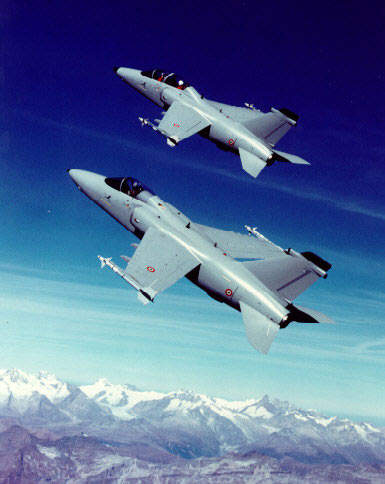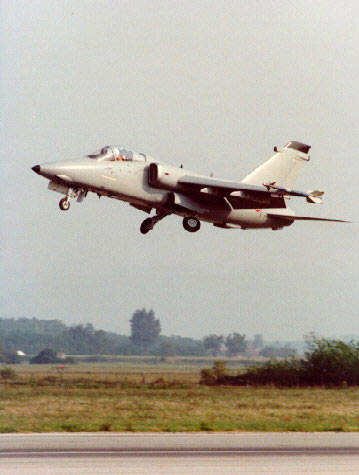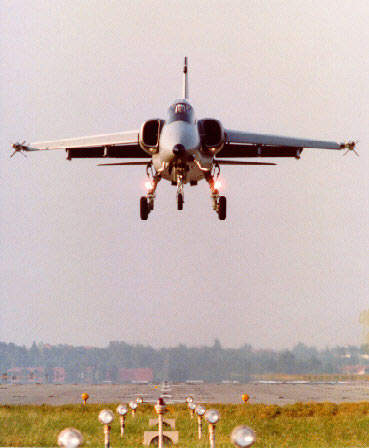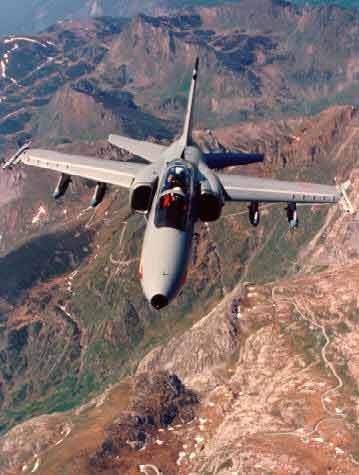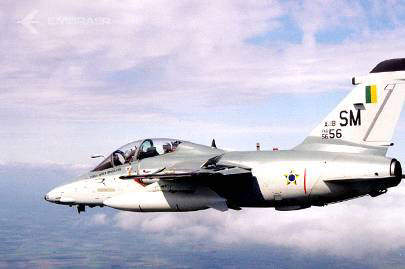The AMX fighter-bomber aircraft is in service with the air forces of Brazil, Italy and Venezuela. The first AMX aircraft was delivered to the Italian Air Force in January 1989 and to the Brazilian Air Force in 1990. The aircraft were produced from the assembly lines in Italy and Brazil. Deliveries to Italy and Brazil concluded in 1998 and 1999 respectively.
In total, 192 aircraft, 155 single-seater and 37 AMX-T two-seater, were delivered to Italy (110 AMX, 26 AMX-T) and Brazil (79 AMX, 15 AMX-T).
The main role of the AMX is ground attack in visual and marginal weather conditions, with primary roles in long-range strike and air interdiction, close air support, reconnaissance and armed patrol. The aircraft is also highly effective in air defence missions and the lead-in fighter role.
AMX international fighter-bomber programme
The AMX programme originated from a requirement of the Italian Air Force for single-seater and two-seater combat aircraft for surface attack missions.
In 1982, a memorandum of understanding was signed by Italy and Brazil and the joint development and production programme was subsequently conducted by AMX Consortium, based in Rome, through Italian companies Alenia Aerospazio, now Alenia Aeronautica, (46.5%) and Aermacchi (23.8%) as well as the Brazilian company Embraer (29.7%).
In December 2002, the Venezuelan Air Force signed a contract with Embraer for 12 AMX-T. However, the USA blocked the transfer of US-built components and the order was cancelled.
Brazilian Air Force AMX upgrade programme
In August 2004, the Brazilian Air Force signed a contract with Embraer for a mid-life update of 53 single-seat (designated A-1A) and two-seat (A-1B) aircraft. The programme failed to receive funding, but in August 2007, Embraer received the first of three prototype aircraft to be upgraded. Elbit of Israel was awarded a development contract for the avionics upgrade of two prototype aircraft in November 2008. The upgrade includes three new multi-function colour displays, head-up display, helmet-mounted display, a new radar, a radar warning receiver, forward-looking infrared system, laser target designator, datalink, night-vision goggle (NVG) compatibility and new communications and navigation suite. The upgrade programme is currently underway.
Embraer was contracted by the Brazilian Air Force in January 2011 to modernise the structural components, and supersede and renovate the outdated equipment of 43 AMX fighters. It is a follow on contract to the upgrade contract signed in August 2004. Flight testing of the modernised AMX, designated A-1M, began in 2012 and the first delivery was made in September 2013.
Brazilian Air Force received three A-1M bombers as of September 2016.
Italian Air Force AMX upgrade programme
In February 2005, the Italian Air Force selected Alenia Aeronautica to upgrade 55 AMX aircraft with new avionics, including INS/GPS navigation system, new communications systems and IFF (interrogation friend or foe), new displays and the addition of a capability to deploy smart munitions such as the Boeing joint direct attack munition (JDAM). First flight of the upgraded aircraft was in September 2005 and the first upgraded aircraft was delivered in March 2007.
Construction
Alenia manufactures the central section of the fuselage, the nose radome, the ailerons and spoilers and the tail surfaces. Aermacchi is responsible for the forward fuselage, the integration of the gun and avionics, the canopy, and the tailbone. Embraer is responsible for the air intakes, the wings, the leading edge slats and flaps. Embraer is also responsible for the wing pylons, the external fuel tanks and the reconnaissance pallets. Final assembly is carried out in both Italy and Brazil.
AMX-ATA advanced trainer aircraft
The AMX advanced trainer attack (AMX-ATA) is a new AMX two-seater, multi-mission attack fighter for combat roles and advanced training. The AMX-ATA incorporates new sensors, a forward looking infrared, helmet-mounted display, a new multi-mode radar for anti-air and anti-ship capability, and new weapon systems such as anti-ship missiles and medium-range missiles.
The Venezuelan Air Force ordered eight AMX-ATAs in 1999 for the advanced trainer and attack aircraft role.
Weapons systems of AMX fighter aircraft
The AMX’s computerised weapon aiming and delivery system, supplied by Alenia, includes the radar and the stores management system.
The AMX can carry external loads up to 3,800kg. The aircraft has seven hardpoints – one on the centreline of the underside of the fuselage, two hardpoints under each wing and wingtip rails on each wing.
The aircraft can carry air-to-air missiles, air-to-surface missiles, free-fall bombs, retarded bombs, laser-guided bombs, cluster bombs, precision-guided munitions and rocket launchers.
The Italian Air Force AMX aircraft are equipped with GBU-12 bombs, fitted with the Opher imaging infrared terminal guidance kits supplied by Elbit of Israel. The wingtip launchrails can carry the AIM-9L infrared guided Sidewinder air-to-air missile, or the Orbita MAA-1 Piranha air-to-air missile.
The Italian AF AMXs are armed with Lizard laser-guided bombs from Elbit. The bombs have 500lb mk82 warheads. The US JDAM joint direct attack munition is also fitted on the Italian AMX.
The Italian aircraft are armed with the M61A1 multi-barrel cannon with 350 rounds of 20mm ammunition installed in the port lower side of the fuselage. The Brazilian Air Force AMX is armed with two DEFA 554 30mm cannon, installed one on each side of the fuselage.
Countermeasures system
The aircraft is equipped with an active and passive electronic countermeasures system supplied by Elettronica. The radar warning receiver is mounted in the tail fin.
Cockpit systems
The pressurised and air-conditioned cockpit is fitted with a Mark 10L zero ejection seat developed by Martin-Baker, based in Uxbridge, UK. The cockpit’s environmental control system is supplied by Microtecnia. The single-piece wrap-around windscreen and single-piece canopy give the pilot a very clear view of the airspace and also a forward-downward view of 18° over the nose. The cockpit is NVG-compatible.
The cockpit is equipped with an Opto Mechanik and Alenia head-up display and an Alenia multi-function head-down digital data display.
Avionics systems
The avionics systems are pallet-mounted for fast and efficient access for service and maintenance. The modularity of the systems allows alternative or upgraded systems to be installed.
The aircraft is equipped with UHF and VHF communications and an identification friend or foe (IFF) interrogator.
Radar systems
The Italian Air Force AMXs are equipped with a variant of the EL/M-20001B radar, operating at I band. Fiar in Italy manufactures the radar, which is designed by Elta in Israel. The AMX in operation with the Brazilian Air Force is equipped with the Fiar / Tectelcom SCP/01 radar. Venezuelan AF planes house Elta EL/M-2032 radar.
Reconnaissance systems
The aircraft retains its normal level of self-defence and attack capabilities when it is equipped for reconnaissance missions. The camera bay, just forward of the mainwheel bay on the starboard side, can hold the pallet-mounted photographic reconnaissance systems supplied by Aeroeletronica of Brazil.
An electro-optical infrared pod can be carried on the pylon on the centreline of the fuselage. For reconnaissance and battle damage assessment, the electro-optical and infrared system is equipped with digital recording and a data link.
A number of AMX aircraft in service with the Italian Air Force are fitted with the Oude Delft reconnaissance pod.
Rolls-Royce turbofan engine
The aircraft is powered by the Rolls-Royce Spey Mark 807 non-afterburn turbofan engine, which develops 49.1kN. The engines are built under a licensed manufacturing agreement by Alfa Romeo Avio, Fiat and Piaggio in Italy, and by Companhia Electro-Macanica in Brazil. A Fiat FA 150 Argo auxiliary power unit is used for starting the engine.
The aircraft carries 3,500l of fuel in internal tanks, which gives a mission attack radius of typically 550km with a five-minute combat time over the target area. The internal tanks are self-sealing rubber bag tanks in the fuselage and two integral wing tanks.
The ferry range is extended to 4,000km, with two 1,100l and two 580l auxiliary fuel tanks carried on the wing pylons. The range and endurance time are also extended by in-flight refuelling, using a probe and drogue inflight refuelling system.
Performance
The AMX can climb at the rate of 50.06m/s and fly at a maximum speed of 1,053km/h. The range and service ceiling of the aircraft are 889km and 13,000m respectively.
The Global Military Aircraft Market 2011-2021
This project forms part of our recent analysis and forecasts of the global Military Aircraft market available from our business information platform Strategic Defence Intelligence. For more information click here or contact us: EMEA: +44 20 7936 6783; Americas: +1 415 439 4914; Asia Pacific: +61 2 9947 9709 or via email.

